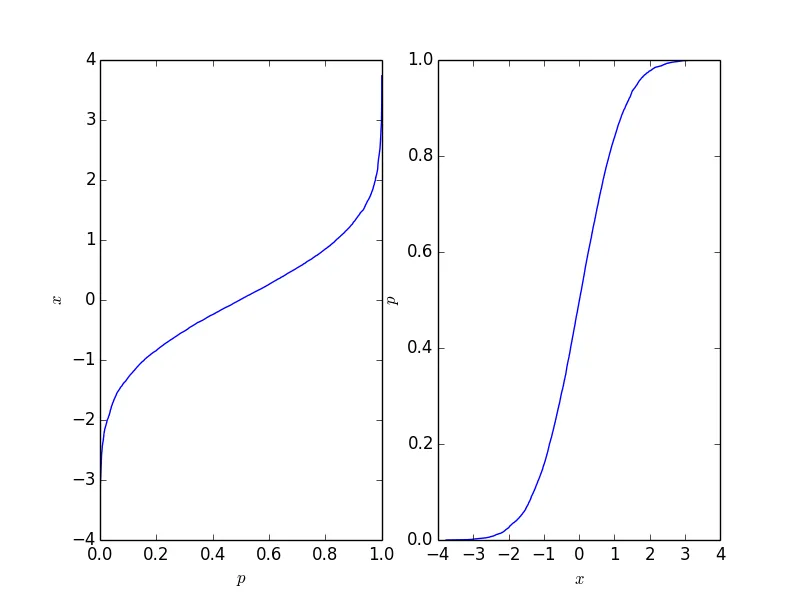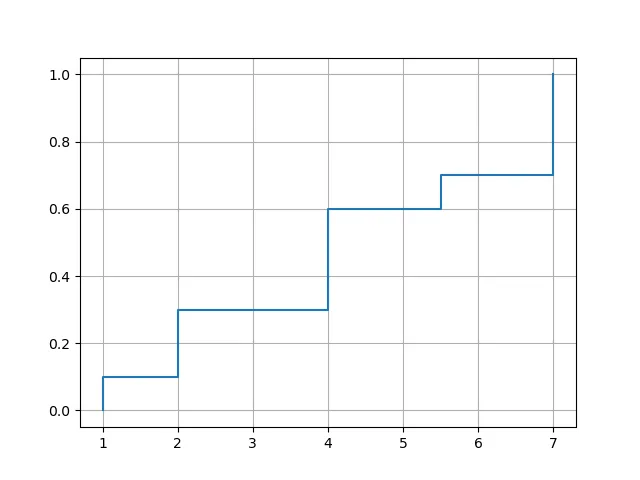我该如何在Python中计算累积分布函数(CDF)?
我想从我有的点数组(离散分布)计算它,而不是使用连续分布,比如scipy中有的。
import matplotlib.pyplot as plt
import numpy as np
# create some randomly ddistributed data:
data = np.random.randn(10000)
# sort the data:
data_sorted = np.sort(data)
# calculate the proportional values of samples
p = 1. * np.arange(len(data)) / (len(data) - 1)
# plot the sorted data:
fig = plt.figure()
ax1 = fig.add_subplot(121)
ax1.plot(p, data_sorted)
ax1.set_xlabel('$p$')
ax1.set_ylabel('$x$')
ax2 = fig.add_subplot(122)
ax2.plot(data_sorted, p)
ax2.set_xlabel('$x$')
ax2.set_ylabel('$p$')
这会生成以下图形,其中右侧的图形是传统的累积分布函数。它应该反映出点背后的过程的CDF,但自然地,只要点的数量有限,它就不会像那么长。

这个函数很容易反转,而它所需的形式取决于您的应用程序。
np.linspace(0, 1, len(data)) 比 1. * arange(len(data)) / (len(data) - 1) 更加简洁。 - charmoniumQf = lambda x: np.interp(x, p, data_sorted)。接下来,例如,您可以使用 f(0.5) 来获取中位数,但不要改变原来的意思。 - charmoniumQlinspace,但值得一提的是最好使用 np.linspace(0, 1, len(data), endpoint=False) 或者 np.arange(len(data)) / len(data),否则它不是CDF的无偏估计。我喜欢这篇帖子,其中有详细的解释:https://dev59.com/LXA75IYBdhLWcg3wlqSh#11692365。 - Nerxis假设您知道数据的分布方式(即您了解数据的概率密度函数),那么在计算累积分布函数时,scipy 支持离散数据。
import numpy as np
import scipy
import matplotlib.pyplot as plt
import seaborn as sns
x = np.random.randn(10000) # generate samples from normal distribution (discrete data)
norm_cdf = scipy.stats.norm.cdf(x) # calculate the cdf - also discrete
# plot the cdf
sns.lineplot(x=x, y=norm_cdf)
plt.show()
我们甚至可以打印累积分布函数的前几个值来展示它们是离散的。
print(norm_cdf[:10])
>>> array([0.39216484, 0.09554546, 0.71268696, 0.5007396 , 0.76484329,
0.37920836, 0.86010018, 0.9191937 , 0.46374527, 0.4576634 ])
同样的方法用于计算多维cdf也是可行的:下面我们使用2d数据来说明。
mu = np.zeros(2) # mean vector
cov = np.array([[1,0.6],[0.6,1]]) # covariance matrix
# generate 2d normally distributed samples using 0 mean and the covariance matrix above
x = np.random.multivariate_normal(mean=mu, cov=cov, size=1000) # 1000 samples
norm_cdf = scipy.stats.norm.cdf(x)
print(norm_cdf.shape)
>>> (1000, 2)
scipy.stats.norm() 的原因 - scipy 支持多种分布。但是,你需要事先了解你的数据如何分布,才能使用这样的函数。如果你不知道数据如何分布,并且只是使用任何分布来计算 cdf,那么你很可能会得到不正确的结果。x 的意义。相反,向量 x 应该是通过 linespace 函数来绘制你从 scipy.stats 中使用的参数化版本的 cdf。无论如何,OP要求非参数化的 CDF,他正在寻求离散但很可能意味着非参数化的 ECDF。 - jlandercya,您可以通过先获取值的频率来计算经验CDF。numpy函数unique()在此非常有用,因为它不仅返回频率,还返回按排序顺序排列的值。要计算累积分布,请使用cumsum()函数并除以总和。以下函数返回排序后的值和相应的累积分布:import numpy as np
def ecdf(a):
x, counts = np.unique(a, return_counts=True)
cusum = np.cumsum(counts)
return x, cusum / cusum[-1]
要绘制经验分布函数,您可以使用matplotlib的plot()函数。选项drawstyle='steps-post'确保跳跃发生在正确的位置。但是,您需要在最小数据值处强制进行跳跃,因此需要在x和y前面插入一个额外的元素。
import matplotlib.pyplot as plt
def plot_ecdf(a):
x, y = ecdf(a)
x = np.insert(x, 0, x[0])
y = np.insert(y, 0, 0.)
plt.plot(x, y, drawstyle='steps-post')
plt.grid(True)
plt.savefig('ecdf.png')
使用示例:
xvec = np.array([7,1,2,2,7,4,4,4,5.5,7])
plot_ecdf(xvec)
df = pd.DataFrame({'x':[7,1,2,2,7,4,4,4,5.5,7]})
plot_ecdf(df['x'])
带有输出结果:

计算离散数列的CDF:
import numpy as np
pdf, bin_edges = np.histogram(
data, # array of data
bins=500, # specify the number of bins for distribution function
density=True # True to return probability density function (pdf) instead of count
)
cdf = np.cumsum(pdf*np.diff(bins_edges))
pdf的长度为bins(这里是500),而bin_edges的长度为bins+1(这里是501)。cumsum函数,简单地计算累积宽度(np.diff(bins_edges))乘以pdf 。cdf = np.cumsum(pdf*np.diff(bin_edges))。 - Jimpd.cut 将数据按照等距离的区间进行排序,然后使用 cumsum 计算分布。def empirical_cdf(s: pd.Series, n_bins: int = 100):
# Sort the data into `n_bins` evenly spaced bins:
discretized = pd.cut(s, n_bins)
# Count the number of datapoints in each bin:
bin_counts = discretized.value_counts().sort_index().reset_index()
# Calculate the locations of each bin as just the mean of the bin start and end:
bin_counts["loc"] = (pd.IntervalIndex(bin_counts["index"]).left + pd.IntervalIndex(bin_counts["index"]).right) / 2
# Compute the CDF with cumsum:
return bin_counts.set_index("loc").iloc[:, -1].cumsum()
s = pd.Series(np.random.randn(10000))
cdf = empirical_cdf(s, n_bins=100)
fig, ax = plt.subplots()
ax.scatter(cdf.index, cdf.values)
import random
import numpy as np
import matplotlib.pyplot as plt
def get_discrete_cdf(values):
values = (values - np.min(values)) / (np.max(values) - np.min(values))
values_sort = np.sort(values)
values_sum = np.sum(values)
values_sums = []
cur_sum = 0
for it in values_sort:
cur_sum += it
values_sums.append(cur_sum)
cdf = [values_sums[np.searchsorted(values_sort, it)]/values_sum for it in values]
return cdf
rand_values = [np.random.normal(loc=0.0) for _ in range(1000)]
_ = plt.hist(rand_values, bins=20)
_ = plt.xlabel("rand_values")
_ = plt.ylabel("nums")
cdf = get_discrete_cdf(rand_values)
x_p = list(zip(rand_values, cdf))
x_p.sort(key=lambda it: it[0])
x = [it[0] for it in x_p]
y = [it[1] for it in x_p]
_ = plt.plot(x, y)
_ = plt.xlabel("rand_values")
_ = plt.ylabel("prob")
numpy.cumsum,我认为您首先需要计算PDF,这是一种开销。 - wizbcnstatsmodels中找到。 - jlandercy